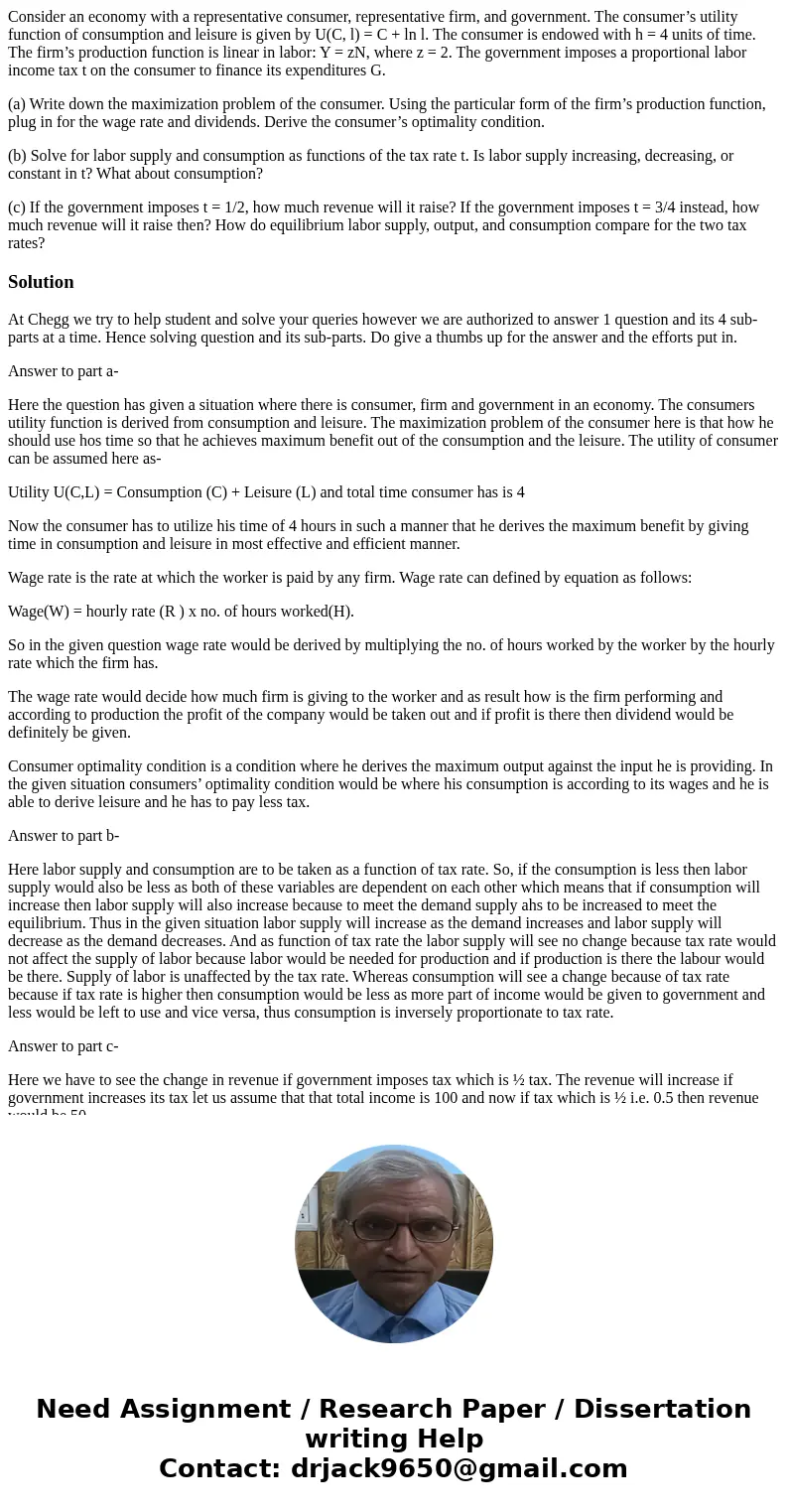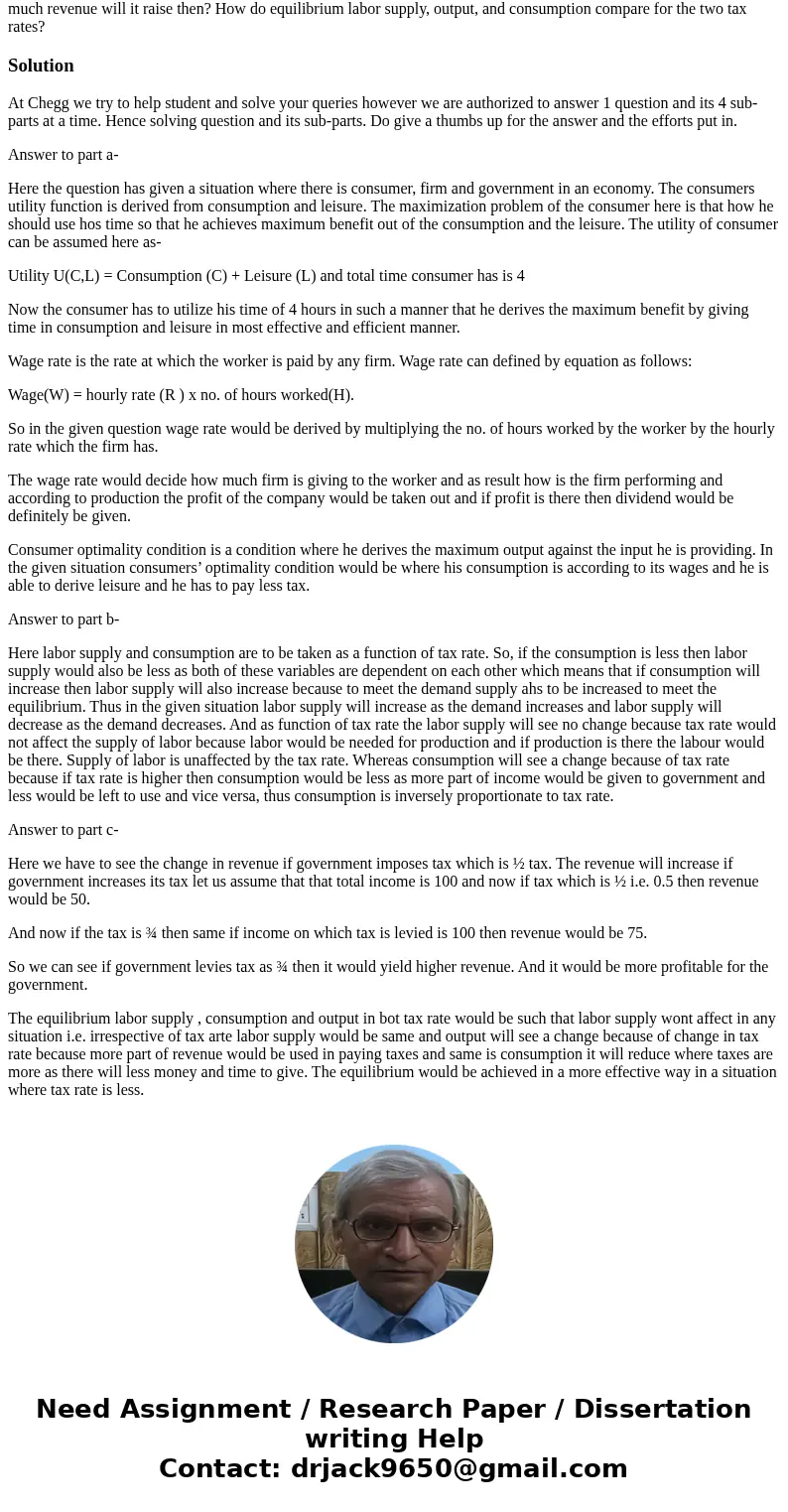Consider an economy with a representative consumer represent
Consider an economy with a representative consumer, representative firm, and government. The consumer’s utility function of consumption and leisure is given by U(C, l) = C + ln l. The consumer is endowed with h = 4 units of time. The firm’s production function is linear in labor: Y = zN, where z = 2. The government imposes a proportional labor income tax t on the consumer to finance its expenditures G.
(a) Write down the maximization problem of the consumer. Using the particular form of the firm’s production function, plug in for the wage rate and dividends. Derive the consumer’s optimality condition.
(b) Solve for labor supply and consumption as functions of the tax rate t. Is labor supply increasing, decreasing, or constant in t? What about consumption?
(c) If the government imposes t = 1/2, how much revenue will it raise? If the government imposes t = 3/4 instead, how much revenue will it raise then? How do equilibrium labor supply, output, and consumption compare for the two tax rates?
Solution
At Chegg we try to help student and solve your queries however we are authorized to answer 1 question and its 4 sub-parts at a time. Hence solving question and its sub-parts. Do give a thumbs up for the answer and the efforts put in.
Answer to part a-
Here the question has given a situation where there is consumer, firm and government in an economy. The consumers utility function is derived from consumption and leisure. The maximization problem of the consumer here is that how he should use hos time so that he achieves maximum benefit out of the consumption and the leisure. The utility of consumer can be assumed here as-
Utility U(C,L) = Consumption (C) + Leisure (L) and total time consumer has is 4
Now the consumer has to utilize his time of 4 hours in such a manner that he derives the maximum benefit by giving time in consumption and leisure in most effective and efficient manner.
Wage rate is the rate at which the worker is paid by any firm. Wage rate can defined by equation as follows:
Wage(W) = hourly rate (R ) x no. of hours worked(H).
So in the given question wage rate would be derived by multiplying the no. of hours worked by the worker by the hourly rate which the firm has.
The wage rate would decide how much firm is giving to the worker and as result how is the firm performing and according to production the profit of the company would be taken out and if profit is there then dividend would be definitely be given.
Consumer optimality condition is a condition where he derives the maximum output against the input he is providing. In the given situation consumers’ optimality condition would be where his consumption is according to its wages and he is able to derive leisure and he has to pay less tax.
Answer to part b-
Here labor supply and consumption are to be taken as a function of tax rate. So, if the consumption is less then labor supply would also be less as both of these variables are dependent on each other which means that if consumption will increase then labor supply will also increase because to meet the demand supply ahs to be increased to meet the equilibrium. Thus in the given situation labor supply will increase as the demand increases and labor supply will decrease as the demand decreases. And as function of tax rate the labor supply will see no change because tax rate would not affect the supply of labor because labor would be needed for production and if production is there the labour would be there. Supply of labor is unaffected by the tax rate. Whereas consumption will see a change because of tax rate because if tax rate is higher then consumption would be less as more part of income would be given to government and less would be left to use and vice versa, thus consumption is inversely proportionate to tax rate.
Answer to part c-
Here we have to see the change in revenue if government imposes tax which is ½ tax. The revenue will increase if government increases its tax let us assume that that total income is 100 and now if tax which is ½ i.e. 0.5 then revenue would be 50.
And now if the tax is ¾ then same if income on which tax is levied is 100 then revenue would be 75.
So we can see if government levies tax as ¾ then it would yield higher revenue. And it would be more profitable for the government.
The equilibrium labor supply , consumption and output in bot tax rate would be such that labor supply wont affect in any situation i.e. irrespective of tax arte labor supply would be same and output will see a change because of change in tax rate because more part of revenue would be used in paying taxes and same is consumption it will reduce where taxes are more as there will less money and time to give. The equilibrium would be achieved in a more effective way in a situation where tax rate is less.


 Homework Sourse
Homework Sourse